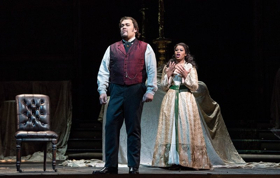Review: At the Met, LAMMERMOOR is Filled with Crazies--and Not Just LUCIA

Photo: Jonathan Tichler/Met Opera
Donizetti's LUCIA DI LAMMERMOOR--the story of a fragile young woman, Lucia, who's caught in a feud involving her family, the Ashtons, and the Ravenswoods--is one of the mainstays of the repertoire at major opera houses around the world, famed particularly for its mad scene: Lucia kills her new husband, Arturo Bucklaw (a marriage of political convenience), and she goes even further downhill from there.
It's long been a favorite at the Met, with the current performances the third cast of the season, starring soprano Pretty Yende, tenor Michael Fabiano and baritone Quinn Kelsey. The company did its first performances of the opera in 1883 and it immediately caught on; between 1903 and 1972, it was never gone for more than a season. The current production dates from 2007.

Photo: Jonathan Tichler/Met Opera
With its score filled with thrills and trills, it was long a staple of sopranos in the songbird tradition. That changed when Maria Callas took it on, back in the early '50s, and made the drama as important as the singing (or more so). The performance record since Callas hasn't been quite so regular--though sopranos like Joan Sutherland, Beverly Sills, Renata Scotto and, more recently, Anna Netrebko, Natalie Dessay and Diana Damrau, have kept it afloat.
Yende--who has had her greatest successes at the Met in comic roles, where she excels--falls somewhere between the two styles, and had some pretty tough going for the first half of the opera. For example, her entry scene, "Regnava nel silenzio ([Night] reigned in the silence)," was underpowered. While she rose to the occasion with some good singing in the Mad Scene, her portrayal remains a work in progress-and she's seemed the least "mad" of the principals.
By the time Lucia came on stage, in fact, something unusual had already happened: Baritone Kelsey, as her brother Enrico, had already tilted the story in a different way, with his two-part introduction, "Cruda, funesta smania (A cruel and bloody feeling)" and "La pietade in suo favore (The compassion for her)." While the role is key to the story, it rarely makes the impression that it did here. With his powerful voice and staggering stage presence, Kelsey made you understand why Lucia was scared of him and why the threat to his family made him somewhat unhinged.
The tenor role, which was a favorite of Enrico Caruso, with its potent tomb scene in Act III and a pair of gorgeous arias, " Tombe degl'avi miei (Graves of my ancestors)" and "Tu che a Dio spiegasti l'ali (You who have spread your wings to God). Unfortunately, it became an opportunity for Fabiano to bounce around the stage often with a manic glint in his eye. I've heard him sing well--Alfredo in TRAVIATA comes to mind--so it was a disappointment to hear his lack of nuance here. (I assume that assistant stage directors Sarah Ina Meyers and Daniel Rigazzi couldn't help rein him in.)
Rounding out the principals were sonorous bass Alexander Vinogadov (memorable from the recent LUISA MILLER) as the minister, Raimondo; mezzo Edyta Kulczak, a particularly lively presence as Alisa, Lucia's maid; and tenor Mario Chang as Lucia's hapless groom, Arturo.
The production from director Mary Zimmerman updates the action from the 17th century to the Victorian era for no particular dramatic reason, though it allowed a cute "photo op" at the end of Act II's famous sextet (Lucia, Enrico, Edgardo and Raimond, as the center, with Arturo and Alisa), as the group poses for a photographer.
Conductor Roberto Abbado led a brisk account of the score with the Met orchestra in fine form. Special kudos for the harp solo from Emmanuel Ceysson and the glass harmonica solo in the Mad Scene from Friedrich Heinrich Kern.
###
Additional performances of LUCIA will take place on April 28; May 2, 5 and 10. Curtain times vary: complete schedule here and the running time is about 3 1/2 hours, with two intermissions.
Tickets begin at $25; for prices, more information, or to place an order, please call (212) 362-6000 or visit www.metopera.org. Special rates for groups of 10 or more are available by calling (212) 341-5410 or visiting www.metopera.org/groups.
Same-day $25 rush tickets for all performances of LUCIA are available on a first-come, first-served basis on the Met's Web site. Tickets will go on sale for performances Monday-Friday at noon, matinees four hours before curtain, and Saturday evenings at 2 pm. For more information on rush tickets, click here.
Add Your Comment
Videos

